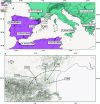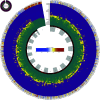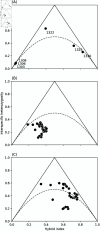Genomic regions of current low hybridisation mark long-term barriers to gene flow in scarce swallowtail butterflies
- PMID: 40209170
- PMCID: PMC12040345
- DOI: 10.1371/journal.pgen.1011655
Genomic regions of current low hybridisation mark long-term barriers to gene flow in scarce swallowtail butterflies
Abstract
Many closely related species continue to hybridise after millions of generations of divergence. However, the extent to which current patterning in hybrid zones connects back to the speciation process remains unclear: does evidence for current multilocus barriers support the hypothesis of speciation due to multilocus divergence? We analyse whole-genome sequencing data to investigate the speciation history of the scarce swallowtails Iphiclidespodalirius and I . feisthamelii, which abut at a narrow ( ∼ 25 km) contact zone north of the Pyrenees. We first quantify the heterogeneity of effective migration rate under a model of isolation with migration, using genomes sampled across the range to identify long-term barriers to gene flow. Secondly, we investigate the recent ancestry of individuals from the hybrid zone using genome polarisation and estimate the coupling coefficient under a model of a multilocus barrier. We infer a low rate of long-term gene flow from I . feisthamelii into I . podalirius - the direction of which matches the admixture across the hybrid zone - and complete reproductive isolation across ≈ 33% of the genome. Our contrast of recent and long-term gene flow shows that regions of low recent hybridisation are indeed enriched for long-term barriers which maintain divergence between these hybridising sister species. This finding paves the way for future analysis of the evolution of reproductive isolation along the speciation continuum.
Copyright: © 2025 Ebdon et al. This is an open access article distributed under the terms of the Creative Commons Attribution License, which permits unrestricted use, distribution, and reproduction in any medium, provided the original author and source are credited.
Conflict of interest statement
The authors have declared that no competing interests exist.
Figures






Similar articles
-
Hybridization in late stages of speciation: Strong but incomplete genome-wide reproductive isolation and 'large Z-effect' in a moving hybrid zone.Mol Ecol. 2023 Aug;32(15):4362-4380. doi: 10.1111/mec.17035. Epub 2023 Jun 14. Mol Ecol. 2023. PMID: 37316984
-
Divergence with gene flow across a speciation continuum of Heliconius butterflies.BMC Evol Biol. 2015 Sep 24;15:204. doi: 10.1186/s12862-015-0486-y. BMC Evol Biol. 2015. PMID: 26403600 Free PMC article.
-
Genome-wide evidence for speciation with gene flow in Heliconius butterflies.Genome Res. 2013 Nov;23(11):1817-28. doi: 10.1101/gr.159426.113. Epub 2013 Sep 17. Genome Res. 2013. PMID: 24045163 Free PMC article.
-
Review. Hybrid trait speciation and Heliconius butterflies.Philos Trans R Soc Lond B Biol Sci. 2008 Sep 27;363(1506):3047-54. doi: 10.1098/rstb.2008.0065. Philos Trans R Soc Lond B Biol Sci. 2008. PMID: 18579480 Free PMC article. Review.
-
Interpreting the genomic landscape of speciation: a road map for finding barriers to gene flow.J Evol Biol. 2017 Aug;30(8):1450-1477. doi: 10.1111/jeb.13047. J Evol Biol. 2017. PMID: 28786193 Review.
References
-
- Campbell C, Poelstra J, Yoder A. What is speciation genomics? The roles of ecology, gene flow, and genomic architecture in the formation of species. Biol J Linnean Soc. 2018;124(4):561–83.
MeSH terms
LinkOut - more resources
Full Text Sources

